A dog crate is a safe and protected den for your Shih Tzu to be in while we cannot supervise them. Of course there are some Shih Tzus who don’t need crates and have never used one, but don’t mistake that for the norm.
How to crate train your Shih Tzu. Crate training your Shih Tzu can be broken down into five easy to follow steps.
.
How to crate train your Shih Tzu puppy fast in five easy steps so you can save time and frustration and you won’t have to be dealing with situations like this also I’m gonna give you some pro tips at the end so make sure you watch all the way to the end because you don’t want to miss out on these pro tips.
Before we begin here’s a quick question. Do puppies prefer to sleep with you in your bed or do they prefer to sleep in a crate? Stay with me and I’ll give you the answer after Step five.
First pick a command word like crate, kennel, bed, home, den but keep it simple, no more than two words.
How To crate train a Shih Tzu puppy fast
Step 1
Introduce the shih tzu puppy to the crate. Bring your puppy to the crate then hold the treat in front of them, let them sniff it and then just put it right inside the crate door.
When your puppy goes into the crate to get to treat, say your command word and praise your puppy. As your puppy gets comfortable going into the crate start putting a treat a little further back each time until it’s all the way to the back of the crate.
Now fortunately with a shih tzu it doesn’t take that far to get to the back, it should be a small crate. Remember to use your command word and praise every time your puppy goes into the crate.
Step 2
Feed your puppy in the crate, when it’s feeding time take the bowl over to the crate, put it just far enough in that your puppy has to enter the crate to eat. Remember always use your command word when a puppy goes into the crate. Each feeding put the bowl a little further back in the crate, once your puppy is comfortable eating in the crate calmly close the door while it’s eating then open it and when it’s done.
close the door in a smooth fluid motion, you don’t want to do anything that will startle your puppy. After about 6 feedings keep the door closed for about one minute after your puppy is finished eating, slowly keep increasing the time name’s the doors closed after feeding just about one to two minute increases. if your puppy starts whining you’ve increased the time to fast.
This is important so listen up. If your puppy starts whining or crying do not let them out until they stop. If you let them out while whimpering they will start doing it all the time. Without saying a word just stand or sit by the crate until your puppy stops whining then just calmly open the door and let them out. Also it’s important to take them outside to potty before you feed him in a crate to make sure they aren’t whimpering because they have to go to the bathroom.
Step 3
Practice with longer crating times. Call your puppy over to the crate, put a treat in the crate and when they go and remember to say your command word and praise them.
When Crate Training a Puppy What Should Be in The Crate?
Once in the crate give them another treat then calmly close the door. Staying silent, sit or stand quietly next to the crate for about 3 minutes, then let them out and praise them. It
helps to have their favorite toy in the crate.
After a few times doing this walk out of sight for about 15 seconds, then come right back in. Do it calmly and quietly because you don’t want to get your puppy excited or for it to think
you’re playing a game.
Start doubling the time that you’re out of sight from 15 seconds to 30 seconds, 60 seconds, 2 minutes etc Working all the way up to 30 minutes. Do this over several days, remember if your puppy starts whining or crying just stand or sit quietly next to the crate until they stop before letting them out.
Step 3
Once you hit the 30 minute mark and your puppy is staying calm and relaxed in a crate you can start leaving them in the crate while you’re gone. when you’re ready to leave say your command
word if you have diligently been using your command word, they should be readily responding to it by now.
When they go into crate give them a treat and praise them, then calmly close the door and leave. don’t make a big deal about this, don’t make a fuss, do not do anything to get the puppy excited just calmly and matter-of-factly close the door and leave.
Start with short 10 to 20 minute trips and slowly increase the time, never leave a puppy and for more than two hours. Adult Shih Tzus should never be left in the crate for more than four hours.
Step 5
Night crate training. Put the crate in or near your bedrooms, say your command word then give them a treat and praise them for going in. Calmly close the door and go to bed, after your puppy is comfortable sleeping in a crate you can gradually move it away.
Puppies will need to go potty often through the night so be sure to take them outside every time they start whimpering, then when you bring them back in say your command word, praise them and calmly close the door.
You have successfully crate trained your Shih Tzu puppy, congratulations.
Before we get to the pro tips remember the question from the beginning? new puppies prefer to sleep in bed with you or in a crate?
Well, what’s your answer bed or crate?
The answer is crate.
Shih Tzus are den animals and they feel safer and more secure in small spaces like a crate.
Shih Tzus want to please you and they feel more secure and happy when they are pleasing you the problem is if you don’t take the time to train them they don’t understand what behavior
pleases you and consequently they don’t understand what behavior displeases you. Then when they do something wrong they’re confused why you’re upset
This can cause anxiety, stress and general angst in a Shih Tzu. help your Shih Tzu be happier more secure by investing in a quality training program. you don’t have to spend a lot of money and it just takes about five to 15 minutes a day.
When you’re in step four and you’re ready to leave your puppy in a crate for long periods of time get it tired by playing it with it and then taking for a walk so it can do its business.
During night training be sure to keep the crate close enough that you can hear your puppy whimpers when it needs to go potty.
Don’t put towels rugs pillows or other fabrics in the crate because at some point your puppy will probably start shredding them, leave them some indestructible chew toys in the crate but nothing too small or they can have little bits chewed off that might become a choking hazard.
Step 1 – Use moist meaty nutritious food that can be easily broken into small pieces, these training exercises require a high reinforcement rate so choose your reinforcements wisely.
Teach your puppy that the crate offers an abundance of good things by scattering high-value food on the blanket inside the crate. at the beginning you might say that they are weary of walking inside, be patient and give them time to think and give them the opportunity to look around for more tidbits that they might have missed.
At the beginning your puppy will start off with two paws in and two paws out, or they might walk in with all four paws and reverse out. Let your puppy progress at their own pace. avoid the temptation to force your puppy into the crate this will only prolong the process.
Step 2 – Capture the moment your puppy turns in your direction by immediately delivering food, be generous and provide as many rewards as possible before they ever even think to walk back out.
Step 3 – Once your puppy is comfortably walking in and turning around in the crate you can move on to what I like to call the Texas two step.
Offer reinforcement when they step in, and turn around and withhold reinforcement when they step out. Empowering your puppy to choose between being inside and outside the crate will reduce anxiety and form a positive relaxed association with these create training exercises.
Reinforce your puppy for 15 to 20 seconds using a high reinforcement rate, then entice your puppy to walk back out by drumming on the floor in front of the crate. With hold on reinforcement when your puppy steps out to create contrast and build value for being inside.
If your puppy starts focusing on you be still, don’t move or talk to your puppy you want to give her the opportunity to reorient to the crate.
Step 4 – Once your puppy begins to show a clear preference for being inside the crate you can raise the criteria by luring her into a sit. Again reinforce for the duration of time that your puppy remains Innocent inside the crate and then ask her to step out by drumming on the floor.
Step 5 – If your puppy is comfortable and confident with all exercises up until this point you can begin to raise the criteria further by closing the crate door.
As soon as you close the gate give your puppy four to six rewards and rapid secession before opening the gate again. If you’re able to give your puppy two or three more rewards if she doesn’t attempt to bust out as soon as the crate door is open.
Repeat this process a few times over, we want to make sure that she is just as relaxed with the gate closed as she is with the gate open.
Loss of appetite pawing or biting at the gate, stress whining or frustrated barking and rushing the gate when you open it are all indications that you should drop your criteria and go back to a more basic exercise.
Pushing your puppy past their comfort zone will only prolong the training process.
The next step is to close the gate and walk away momentarily, the goal throughout this entire process is to keep the puppy below their stress threshold. The more gradual you are in building criteria the better your results will be.
Close the gate, reinforce, walk away five to ten feet and then immediately walk back and reinforce your puppy. Repeat this a few times over before opening the gate, again reinforce your puppy if she remains calmly inside the gate when the gate opens. Physical restraint fuels anxiety, mental restraint builds calm behavior.
Every puppy will progress at a different rate the better you are reading your puppy’s behavior and body language and adjusting criteria accordingly, the better your training will be. The fact that Harley is settling into a relaxed down is a good indication that training criteria has been set according to her individual needs.
To close the gap between these formal training sessions and practical use of the crate I will start off by having the puppy in the crate while I grab a glass of water, take a snack from the fridge or go to check the mail.
Intermittently reinforcing the puppy for calm behavior as I gradually increase the duration of time she spends inside the closed-door crate.
I might also sit nearby and read a few chapters from a book, it’s extremely helpful to have your puppy sleep in a closed-door crate near your bed at night so that she associates it with a place of rest and relaxation.
Providing a special high value to eat like a bully stick is one more way to solidify your puppy’s positive association with the crate.
Table of Contents
Why Crate Training Works
For all the “crater haters.” Every time the subject of crates comes up there are a lot of folks that pipe up about how cruel and inhumane it is.
Guys, you’re coming at it totally wrong. You’re misunderstanding how a crate is used and you’re talking about what you like, not what your dog likes.
Dogs are denning animals, ultimately they like it dark and close. This is why dog go under end tables and coffee tables, why they sleep under the covers, why they hang out under your desk, or hide below the printer stand.
Crate Training Power Tip – Bait & Restrain
Now crate training is an important and useful part of raising a puppy or adopting a new adult dog. When we are introducing the crate, even to an experienced dog in a new place, some work with habituating the crate is crucial. This game will help build some interest in the crate.
It’s awesome for puppies, but even older dogs will benefit from this one. It’s really easy to do. But a couple of things first. As always your most effective strategy is praise as we’ve said many times on this blog, your voice is your number one training tool.
Second, timing is important. Don’t try to work on crate training during peak arousal times. Work with your dog, spend time with them, play with them, and wear them out first. You should be aware of your dog’s energy levels and take steps to manage them.
Finally we recommend using a consistent phrase as a prompt to go into the crate. Pairing a word or phrase will help directionalize their attention towards where it needs to be.
For this exercise we’re going to use a little gentle restraint to build drive. A body harness will work best, although if your dog is comfortable being handled by you, you can use your hand on their body.
Don’t hold on to the collar during this exercise since that will just interfere with obedience work later on. Our first training game for any age is the old bait and restrain, so we start by throwing food into the crate and letting your dog toddler and to get it.
This is the super obvious step and everyone does this. But we’re going to kick it up so we can really make some progress. After a few repetitions, gently restrain your dog as you throw the treat inside.
Gentle restraint is a classic drive building strategy. A little bit of positive frustration will make them want it more and work harder to access whatever it is they want.
After a few reps with gentle restraint give your consistent cue and then release. Now you’re teaching your dog that the words are important. We use a similar process to attach verbal prompts to all of the behaviors we teach.
After a few reps pre-bait the crate; distract your dog with food when they come out and throw food in with your other hand so they don’t see you throw it in.
This way your dog doesn’t become dependent on you throwing food into the crate in order to go in. They poke their head in and discover that the food is already there. Next, build a little duration. Toss food while your dog is already in there so they hang out inside a little bit.
Finally, close the gate while your dog is in there during the duration work and feed them through the holes. When your dog has stopped eating let them back out right away. You can build on this process very quickly.
This is much better in the long run rather than just throwing your dog into it and hoping for the best. You want to make that initial movement of going in and coming out fun and pleasant.
This game alone may get the ball rolling well enough but if you need or want another fun crate game check out our other power tip article. And if you want the lowdown on how to choose and use a crate check out our big crate article coming out soon.
Crate Training Power Tip – Bait Locker
When we are introducing the crate, even to an experienced dog in a new place, some work with habituating the crate is crucial. This game will help build some interest in the crate and make the initial movement in and out of the crate fun and dynamic.
First, though there are a few other items on the agenda. As always your first line strategy is praise. Like we’ve said many times on this channel your voice is your number one training tool. Second, timing is important here just as it is in all training.
You should be aligning your work according to your dog’s energy levels. Practice passive things like stays and crate training when your dog is at a lower energy level and when they’re revved up that’s a better time for active things like Come, walking and activities that require movement and energy.
If you’re not working to manage those energy levels then at least plan your crate training time for when they’re on the downside. We also recommend using a consistent phrase as a prompt to go into the crate. Pairing a word or phrase will help directionalize their attention towards where it needs to be.
You’ll also need a hollow toy for this game. We love Kongs and PetSafe barnacles but there are others out there that will work well too: squirrel dudes, Atomic Balls, Chewballs, Quizls, Buster cubes, Goodie Ships and even hollow butcher bones work great.
For this article we’ll use one of our Kongs. As with our previous power tip training game, we’re going to use a little positive frustration to build Drive and motivation. Last time we used gentle restraint; this time we’re going to use a barrier.
So first let’s create the bait
Back in our first power tip article we showed you how to make liver powder. Take a tablespoon of that and mix it with about a cup and a half of kibble. Shake it up and now we’ve got some supercharged kibble that’ll work great for this game. Show your dog the toy and let them watch you putting a few goodies in it.
Put the chew toy in the crate and let your dog toddle in to harvest the goods from the toy. Praise your dog enthusiastically as they work with it. This will help build some good motivation for moving into the crate and for working at the toy.
After a couple of reps like this, if your dog is showing some good enthusiasm, put the toy in and shut the door for a few seconds.
When your dog is asking to go into the crate to get their toy open the door, use your consistent phrase, and let them in. Now we’re creating a real desire to move into the crate. Shut the door while they’re playing and eating, then open it as soon as they’re done.
It’s easy to build duration in this; as you work you can leave them in there a little bit, feed through the holes, and then let them back out. Later you can use the toy for a full meal and your duration inside the crate will skyrocket.
Now admittedly this game won’t work with dogs who have low frustration tolerance. These dogs will give up at the gate or won’t work at the toy. You may need to improve their motivation and drive first if this is problematic.
For starters, manage hunger drive by making sure they’re sufficiently hungry, so do this during mealtimes or maybe withhold a meal until you’re ready to work with this.
You can also begin working by just scattering the food inside the crate and letting them forage for it. This is easier and more immediately gratifying. After a few reps you can do the work as before by closing the gate and waiting for them to really want in.
Is Crate Training For Every Dog?
A crate for sure isn’t necessary for every dog so let’s start by discussing some of the pros and cons to help you decide if it’s right for you. Crates are great for raising a puppy or for helping a new adult dogs settle in.
While they’re learning the ropes around your house a crate can help you control destructive behaviors. If nothing else, blocking access to tempting things like your shoes and underwear may be worth the effort.
Crates are a necessity for quick and effective errorless house training for puppies, of course, but even adult adoptees—even if supposedly potty trained—should still go through the full house training regimen. For mature Shih Tzus that are through the potty training process a crate is rarely a necessity.
Many can be home alone or out during the night. The exception is when there’s a specific behavior problem you’re trying to address; then a crate may be a helpful component to your treatment plan.
Make sure you involve a consultant for these cases. Even for those dog that don’t need a crate, crate trained is a good character trait for a dog to possess as they may be called upon to go into a crate at times nonetheless.
For example if they’re staying somewhere while you’re out of town, or at the vet’s or even at the groomer’s they may need to spend time in a crate. A crate is also the safest option when traveling.
A crate can be a reliable and familiar place in the car for your dog, and for busy dogs they can’t interfere with you while you’re driving.
At home it’s important to have areas of inclusion and areas of confinement or isolation. We need to be able to control our Shih Tzus’ stimulation and to compartmentalize it to the places we want.
It’s irresponsible to just leave that up to chance. We don’t want them jazzed up in the family room at night and we don’t want them wasted out in the yard when we’re trying to interact with them.
Using a crate as part of your practice would help. In any case a crate shouldn’t be used for extended periods. Crates do not provide any outlet for pent-up energy.
If your Shih Tzu is spending time in a crate, you’ve got to make sure you’re countering that confinement with constructive use of physical exercise and mental stimulation.
A crate can be an efficient management tool but don’t make the mistake of making it your babysitter.
Think of it like a crib or playpen. We move through similar stages with babies: cribs, toys, diaper champs, and high chairs, so we need to be working through the same kinds of stages with our dogs.
Ostensibly your Shih Tzu should grow out of the need for it with guidance and support.
Types of Dog Crates
There are several types of crates out there so here’s a basic rundown of the main categories.
Plastic Dog Crates
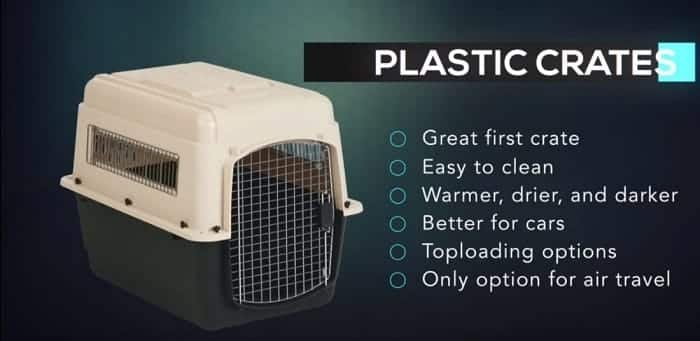
Plastic flight crates are kind of the original standard for crates. Plastic crates are great for a Shih Tzu’s first crate. The plastic is easier to clean up when there are messes, and for big messes you can disassemble the crate to really get in there.
Plastic crates are generally warmer and drier. It’s very easy to throw a blanket on it to darken it even more and this can be very soothing for many dogs.
Plastic crates are usually better for cars; some even have systems to strap them down. Some have top loading options for smaller Shih Tzus.
Plastic crates are the only option for flying if your Shih Tzu is not allowed in the cabin. Most plastic crates are compliant with airline safety standards and plastic crates have lots of affordable options.
Wire Dog Crates
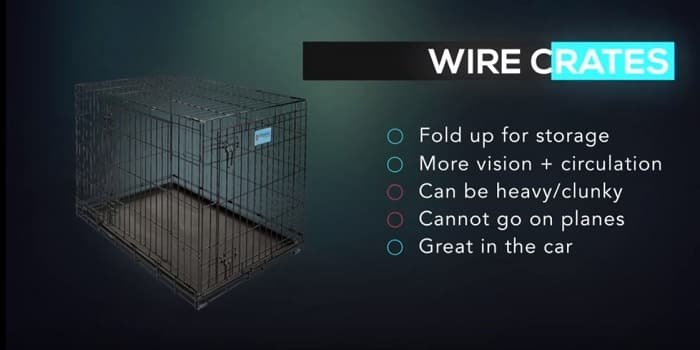
Wire crates are probably the second most common and useful kind of crate. They easily fold up for storage or transport. They offer more vision and more circulation. They can get kind of heavy as they get bigger, though. You also cannot take them on planes. Wire crates are suitable for use in a car.
Wire crates also have a lot of affordable options. Soft sided crates fold up as well but they’re made of lighter materials like nylon, vinyl, and aluminum.
These are best for travel and convenient set up in hotels or campgrounds. They’re not recommended for the crate training process, or for a dog with distress or anxiety.
These are best for Shih Tzus who’ve been trained and are comfortable in a crate. Soft sided crates are affordable but on the higher end.
Fashion Dog Crates
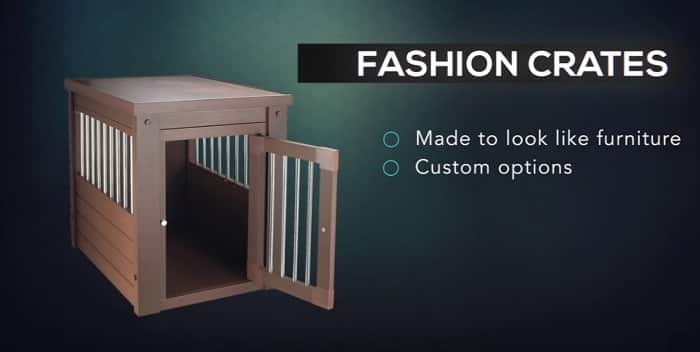
Fashion crates are made of finer grade materials and are made to look like furniture. Some are even custom integrated into existing furniture.
These are also best for a Shih Tzu that’s already accustomed to a crate. These are great for inclusion time and, as you might imagine, fashion crates tend to get kind of expensive.
Heavy Duty Dog Crates
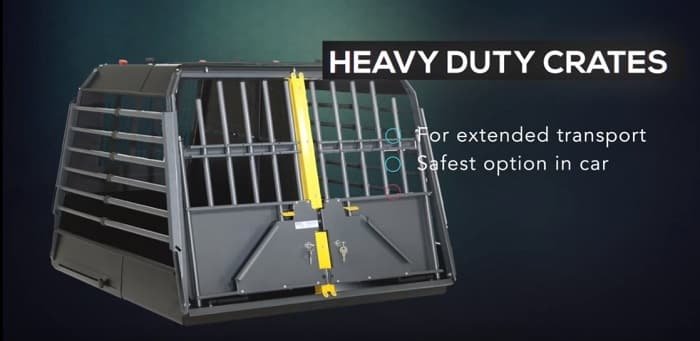
Heavy duty crates are best for extended transport. They’re used mainly by owners that travel with their dogs regularly such as those that travel to competitions or trials.
These are the safest option in the car; they’re built to withstand a full-on car crash. Heavy-duty crates are amongst the most expensive of all the options.
X-Pens Dog Crates
X-pens are also a great addition to your arsenal. They’re a fabulous way-station for your integration routine. They’re awesome for puppies and small breeds. It’s a great inclusion space when you transition from a crate.
They’re movable and portable and they just fold up like a wire crate. They’re not for larger dogs or for highly energetic dogs and dogs are always supervised in these as they can learn to get out.
We typically train this too; we don’t just toss a Shih Tzu into one and hope for the best. Many puppy experts recommend that you start with both a plastic crate and a wire crate and these will be used at different times.
One is for inclusion when your dog is created but is still in proximity with the family, and one we call a “quiet crate” which is covered for, well, quiet alone time.
If you can only afford one then a plastic crate may be the better choice initially. If you’re adopting an older Shih Tzu that is crate trained a wire crate might be just fine. Once you’re through some of those tougher early phases you should be able to progress into soft sided, fashion, or heavy-duty if you desire.
The baseline is that your Shih Tzu needs to be able to stand up, turn around, and lie down comfortably in the crate. This is an easy prospect if you’re adopting an older Shih Tzu that’s pretty much done growing, but for puppies that can be a little more difficult.
Wire crates usually come with a movable divider so you can effectively start the crate small and then enlarge it as the puppy grows. This way you only have to buy one wire crate.
For your plastic crate you’ll have to get one big enough to last a little while. Ostensibly once your puppy’s potty-trained you may not need your plastic crate.
We won’t cover how to potty train your Shih Tzu in this article as we already have an article on it. If your dog has had a previous bad experience with the crate or is suffering from isolation distress or separation anxiety you will need to seek help from a trainer or behavioral consultant.
Don’t try to force the issue or you’ll just make it worse. For the rest of the dogs out there though it’s usually a pretty straightforward process. We want our dog to view the crate as a safe place. It should be pleasant and inviting, so we need to habituate them to it.
A neutral response is sufficient but a good Conditioned Emotional Response is even better. As with all training there’s a timing issue: monitor and control their energy and don’t try to work on crate training during peak arousal times. Work with them, spend time with them and wear them out first.
Your first line strategy is praise of course. As we’ve said numerous times on this channel your voice is your number one training tool. Consider using a consistent phrase as a cue to go in. As with everything in training pairing a word or phrase will help directionalize their attention towards where it needs to be.
Tie the door back initially so it doesn’t scare your dog. Doors can swing around randomly and clink and clunk on the crate potentially frightening sensitive Shih Tzus and setting your work back.
Don’t work on crate training with your Shih Tzu unless you have food rewards and toy rewards ready. Set this up and make it convenient for you or you probably won’t do it.
Routines are awesome but try not to make your initial training follow a predictable pattern. You want to destabilize the patterns of coming and going to short circuit expectation.
This will preserve the integrity of whatever training you do with the crate. Don’t let your dog make a habit of demanding to be let out if your dog is barking for you to open the door in those early phases, here’s how you fix it:
Crate training is labor-intensive but it reduces the possibility of problems later on. Be patient, practice until your dog enters their crate willingly. Depending on the Shih Tzu this could take several days.
Don’t rush it; your dog will tell you how fast to go. Practice until your dog is alright in the crate for about 30 minutes before leaving the house.
This will minimize stress when you do leave. Make the first leaving a short one, maybe an hour or so. Finally if you make a big production out of letting your dog out you potentially create a couple of situations:
1) You condition your dog to be super aroused when you let them out. These dogs will launch out of the crate at you like a torpedo.
2) The dog starts to feel like being out of the crate is better than being in the crate. These dogs will become more reluctant to go in as time goes by so be enthusiastic about getting into the crate but be just kind of neutral about letting your dog out.
Line your crate with a soft towel or mat. If your dog is chewing up beds, a towel might be a better option until chew-toy training is under wraps. Puppies being potty trained should never be created longer than they can reasonably be expected to hold it.
The general rule of thumb is one hour per month plus one. So at two months you’re looking at approximately two to three hours, three months three or four hours, four months four to five hours and so on. Until potty training is sewn up consider coming home on a lunch break or have someone let the puppy out.
Adults don’t need as many potty breaks although as we mentioned all newly adopted adult Shih Tzus should still undergo a full potty training regimen including crate confinement. Don’t leave food in the crate. There is no situation where your Shih Tzu should require food in the crate.
As we’ve mentioned many times before Shih Tzus should not be free fed, they should be on a routine, timed feedings. And your dog should never be crated so long that they require food available in the crate anyway. The only time food is available in the crate is when we’re toy-feeding them to habituate them to being inside it.
This is a temporary situation during our training progression. Water is a little different. If your Shih Tzu is only in the crate a couple of hours at a time water is not necessary, although if you’re a working stiff and your Shih Tzu spends several hours a day in there you may want to consider making water available.
In this case do not use a bowl, get a water bottle. This is a lot less messy and more compact without taking up internal real estate. However, for those Shih Tzus that spend long hours alone you may want to consider making a bigger Den Apartment.
For adult Shih Tzus you can give them more room to hang out, and the puppy version actually includes a toilet that will expedite your potty training.
We mentioned our recommendation that you have two crates initially: an inclusion crate in a room where you spend the most time and a quiet crate.
This is another method for managing energy. There will be times when your dog needs to settle down for a nap in a dark quiet place and there are times when your dog can hang out with the family but still needs to learn how to occupy themselves.
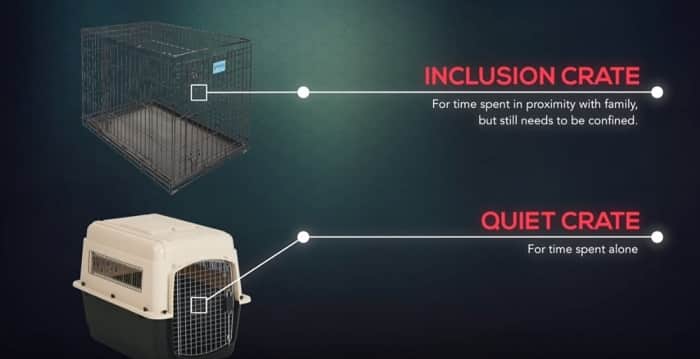
Once they’re supervised, this is a good time for a chew toy and later on this will be a good opportunity to use that X-pen. However you set things up—one crate or two—set up the flow so that you can move your Shih Tzu around easily.
Don’t put their crate in the upstairs back bedroom. Especially if you’re potty training you need to be able to get them outside quickly and easily. Set up your house to make it easy for you or you won’t get it done.
Alright guys! This should cover the majority of your crate training conundrums. If you run into any bigger snags make sure to buddy up with a local trainer to help you iron out those kinks.
